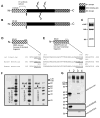ADAMTS expression and function in central nervous system injury and disorders
- PMID: 25622912
- PMCID: PMC5068130
- DOI: 10.1016/j.matbio.2015.01.014
ADAMTS expression and function in central nervous system injury and disorders
Abstract
The components of the adult extracellular matrix in the central nervous system form a lattice-like structure that is deposited as perineuronal nets, around axon initial segments and as synapse-associated matrix. An abundant component of this matrix is the lecticans, chondroitin sulfate-bearing proteoglycans that are the major substrate for several members of the ADAMTSs (a disintegrin and metalloproteinase with thrombospondin motifs) family. Since lecticans are key regulators of neural plasticity, ADAMTS cleavage of lecticans would likely also contribute to neuroplasticity. Indeed, many studies have examined the neuroplastic contribution of the ADAMTSs to damage and recovery after injury and in central nervous system disease. Much of this data supports a role for the ADAMTSs in recovery and repair following spinal cord injury by stimulating axonal outgrowth after degradation of a glial scar and improving synaptic plasticity following seizure-induced neural damage in the brain. The action of the ADAMTSs in chronic diseases of the central nervous system appears to be more complex and less well-defined. Increasing evidence indicates that lecticans participate in synaptic plasticity in neurodegenerative disease states. It will be interesting to examine how ADAMTS expression and action would affect the progression of these diseases.
Keywords: Brevican; Chondroitin sulfate; Glial scar; Neuroplasticity; Proteolytic fragment; Seizure; Spinal cord injury.
Copyright © 2015. Published by Elsevier B.V.
Figures

References
-
- Zimmermann DR, Dours-Zimmermann MT. Extracellular matrix of the central nervous system: from neglect to challenge. Histochem Cell Biol. 2008;130:635–53. - PubMed
-
- Gottschall PE, Sandy JD, Zimmerman DR. Substrates for metalloendopeptidases in the central nervous system. In: Conant K, Gottschall PE, editors. Matrix metalloproteinases in the central nervous system. Imperial College Press; 2005. pp. 87–118.
Publication types
MeSH terms
Substances
Grants and funding
LinkOut - more resources
Full Text Sources
Other Literature Sources
Medical

